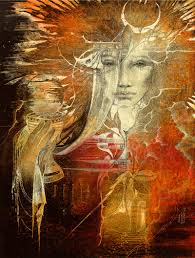
Is Easter related to the pagan goddess Ishtar? Variations of the same name, such as Astarte and Ashtoreth have direct etymological relation to Ishtar, as well as characteristic relation; But is Easter related in the same way? This question has set off a whirlwind of opinions mixed with some truths and speculations of diverse controversies. This article may bring some clarity in discerning facts from assumptions.
First, we’ll start with identifying the pagan Goddess Ishtar, defining her distinct characteristics, and highlight the way her legend was taken with different people throughout the world. Then we’ll look into Easter to see what kind of relation there may be.
Ishtar | Astarte | Ashtoreth
Indeed, Ishtar, Astarte, and Ashtoreth are all name-variations of the same female counterpart of the Babylonian “Holy Trinity” (Baal, Ashtoreth & Tummuz). Anyone familiar with sacred scripture has seen Baal & Ashtoreth repeatedly mentioned in the negative, as Canaanite deities. These deities root to ancient Babylon of King Nimrod, who’s legend morphed into Marduk – the sun-god, known by the Canaanites as Baal; His Queen, Semiramis, representing the moon goddess named Ishtar, known by the Canaanites as Ashtoreth; Last but not least is the immaculately conceived “divine son” Tammuz, believed to be the reincarnation of the sun-god Baal.
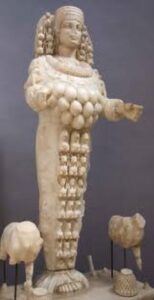
The “Divine Queen-Mother” moon-goddess, Ishtar, represents the grand goddess of love, sex, beauty & fertility – according to the Morning Star, and according to the Evening Star – the goddess of war & hunting. Known as Ashtart by the Phoenicians, and Ashtoreth by Canaanites. Asarte being the Greek transliteration of Ashtart, which different Greek factions rendered other variations such as Aphrodite and Dianna.
The scattering from Babylon caused divisions of people with different languages to carry the same deity-figures with different names and character variations which multiplied to create polytheism. Even with the many variations among the different religious systems, there still remained fundamental characteristics, symbolism & themes which synchronized to keep a common thread. Hence, the various world religions are just different renditions of the same Babylonian System. See Mystery Babylon | The Luciferian Legacy
Here are just some of the different names of Ashtoreth:
- ISIS- by the Egyptians
- ISHTAR- by the Canaanites
- APHRODITE- by the Grecians
- VENUS- by the Romans
- DIANNA- by the Ephesians
- ATHTAR – by the Arabians
- KALI- by the Indians
- COLUMBIA- by North Americans
The different names rendered by different people & languages do not necessarily have etymological relation, but it’s the continuity of distinct theme & characteristic relation of this certain goddess, which is represented through different people of different languages.
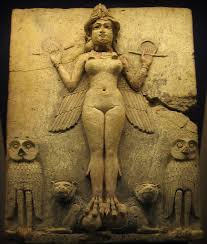
Ashtoreth, the ‘moon goddess’ has also been referred to by certain nicknames such as:
- Divine Mother
- Mother Nature
- Mother of God
- Queen of Heaven
- Virgin Mother
Hmm, who else has been called those names?…
Christian-Pagan Syncretism
Emperor Constantine adopted Christianity, as the state religion for the Roman Empire in the early 4th century. Even with such a Christian Reform, vestiges of Pagan Rome persisted and was later adopted by successive popes in order to absorb the pagan masses of the empire.
The combining of different and contradicting concepts is termed as syncretism. Such an application served the Church & State interest to foster a more cohesive society with a diluted and altered form of Christianity which was more inclusive and less demanding of complete repentance and true conversion. Especially important to the pagan masses was the familiarity of distinct pagan themes which carried through Roman Catholicism.
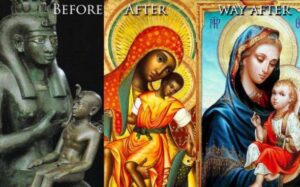
For example, the “Divine Mother & Son” theme of the Babylonian Mysteries was syncretized to the Gospel of Jesus Christ in relation to His mother Mary. Many critics have indicted “Christianity” as a plagiary of the ancient Mysteries, but taking his cue from the original promise of the women’s Seed as recorded in Genesis 3:15, it was Satan who was already producing a counterfeit before the arrival of the genuine article, as he then set out to mix-up and confuse the truth with a lie.
Jeremiah 44 is sufficient enough to see how the “Queen of Heaven” is certainly not a figure who brings honor to the true and living God. The true biblical account of Mary, mother of Jesus, has been twisted into a Pagan deity figure and exalted as the “Queen of Heaven” by the Roman Church. This deity figure is none other than that which has been venerated as Ashtoreth.
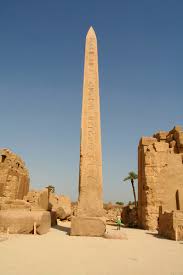
So what are Ashtoreth poles?
The Ashtoreth poles referred to in the scriptures are obscene expressions of the sexual obsession possessed by such Mystery Religions. It is a phallic symbol of sexual intercourse between Baal & Ashtoreth. A monument of the sexual perversions of the temple prostitute tradition.
Such obscene images are not just a thing of the past, but are erected today in the most prominent sites in the world, such as the Washington Monument and the Vatican Plaza (Should that really surprise us when considering who the prince of this world is?).

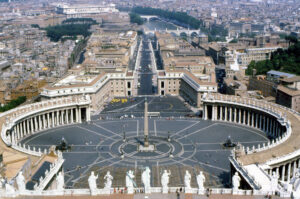
A religious system including “sexual freedom” was a lure which snagged the Israelites time after time, to forsake the one true God, Yahweh. The following verses are just some of the biblical accounts regarding the Baal & Ashtoreth poles which provoked God to great wrath:
~ Exodus 34:13 ~ Deuteronomy 7:5, 12:3 ~ Judges 2:12-14, 10:6 ~ 1 Samuel 7:4, 12:10, 31:10 ~ 1 Kings 11:4-6, 11:33, 14:23 ~ 2 Kings 23:13 ~ 2 Chronicles 14:3, 15:16, 31:1, 34:4 ~ Jeremiah 43:13 ~ Isaiah 17:8, 27:9
Of course this activity would produce children, which reinforced the female counterpart of the “god-head” as the ‘fertility goddess’. Any unwanted children were deemed a “sacrifice” and given as a burnt offering to Baal, also known as Molech. One of the traditions related to child-sacrifice is the dyeing of eggs red, which symbolized the blood sacrifice of their offspring.
The Presumed Notion of Easter Transliterated from Ishtar
There is most definitely an association between the Babylonian tradition of Ishtar and the mainstream Easter tradition, such as fertility elements like eggs & bunnies; But is the word-name Easter another variation of Ishtar? This questions has been the theme of great controversy, some details which can be certain and other details which are more difficult to assess.
One thing for certain, Easter is a Saxon word and Ishtar is a Semitic word, and there is no etymological relation. Furthermore, each word has different meaning so there would be no translation nor transliteration between the two. The fact that Easter and Ishtar are similar sounding is merely a coincidence.
At face value, it may seem Easter would be a different name for Ishtar, especially with the pagan parallels, and many have assumed so, including myself before, but further probing makes it clear there is no direct etymological relation between the two.
Is Easter Related to the Anglo Saxon Goddess Eostre?
The answer is yes, but that does not mean the two word-names are synonymous. This is where too many assumptions have been made – as soon as it’s found there was a Saxon fertility goddess named Eostre, the knee-jerk reaction most well-meaning Christians do is jump to the conclusion that Easter is just a name variation of the goddess Eostre. Lets go deeper before making that assumption.
The Venerable Bede (672-735), in “Reckoning of Time” states the Saxon month for April was named Eostre-monath:
“… Eostur-monath, which now is translated to Paschal-month, was once called after a goddess of theirs named Eostre, and whose name was celebrated in the festival at that time. Now they dedicate that Paschal season by her name, calling the joys of the new festival by the familiar ancient observance.”
With this source, we can see the Saxon month for April, called Eostur-monath, was named after their goddess Eostre, which was celebrated according to their pagan tradition represented by her, but the name of the month was changed to Paschal-month (Passover month). That change seems like a step in the right direction except that it says,
“… Now they dedicate that Paschal season by her name, calling the joys of the new festival by the familiar ancient observance.”
So they adopted a new name and new festival, but it was “by her name” (Eostre), and “by the familiar ancient observance.” This description of blending the Christian Passover with the ancient pagan observance seems much like Roman Catholic syncretism to me. In fact, it was; England had been Catholized at that time and the Venerable Bede was himself a Catholic monk.
The only other primary historical source about the Saxon goddess Eostre, is from Jacob Grimm (1785-1863), authority on ancient Germanic tradition & language; In “Teutonic Mythology”, Grimm tells us the Anglo-Saxon name Eostre is related to the Old High German adverb ostar – expressing movement toward the rising sun (eastward).
What Grimm says in the following excerpt is quite telling on many levels. He says,
“Ostara, Eostre, seems therefore to have been a divinity of the radiant dawn, of upspringing light, whose meaning could easily be adapted to the resurrection-day of the Christian’s God.”
First off, Grimm describes Eostre as,
“… a divinity of radiant dawn, of upspringing light”
Such is distinctive quality which directly corresponds to Ishtar of the Morning Star – the grand-goddess of love, sex & fertility, who is venerated as springing forth with her radiant vitality of the morning light – celebrated during Spring Equinox. So while the name of the Saxon goddess Eostre may not have any etymological relation to the name of Ishtar, there is certainly theme & characteristic relation.
Secondly, Grimm says of Eostre,
“whose meaning could easily be adapted to the resurrection-day of the Christian’s God.”
This suggestion from Jacob Grimm seems to indicate he was not aware that the “Christian God” would have absolutely no share with any kind of so-called pagan god, fables and traditions thereof. However, there was an entity which was very interested in adapting such a pagan tradition to the resurrection-day of the Christian God, which renders Grimm’s suggestion as rather prophetic as to the unrelenting syncretism of the Roman Catholic Church.
And with such an adaption so masterfully implemented & united abroad by the Universal Roman Church, the Saxon goddess Eostre, has made a full circle connection to the Semitic deity Ishtar with all the pagan Easter traditions we’ve become so acquainted with!
However, this still does not prove that Easter is the same as Eostre. So now that we’ve taken a closer look at what Eostre is, lets take a closer look at what Easter is.
Again referring to Jacob Grimm’s point that the goddess name Eostre was derived from the Old High German adverb oster which means Eastward, or movement toward the rising sun. So the name Eostre may be pagan, but that does not make the word it was derived from pagan. In fact, the German word oster was simply a word like the English word East, or Eastward.
Apparently, bible translators like Martin Luther & William Tyndale saw nothing wrong with the word oster; Luther’s German translation rendered the Jewish & Christian Passover with the word oster, and Tyndale’s English translation rendered the Passover with ester, which was just an Anglo-Saxon adaption of the Germanic word oster, which later became easter. So while the Anglo-Saxon word Easter and the pagan name Eostre are both derived from the same German word (oster), each word has had a distinct & different meaning and application.
Now that we’ve established that Easter simply means Eastward, or movement toward the rising sun, which has been applied to the resurrection of Christ, whom the scriptures declare as the Rising Sun, Morning Star, Dayspring (Luke 1:78, 2 Peter 1:19, Rev 22:16), we can simply leave it at that and say “end of story”
However, the relentless deception of Satan is ever before us, specifically targeting the Church of God by twisting the genuine article into a blasphemous counterfeit. Thus, the New Testament abounds with warnings against such insidious deception, and exhorts the saints to exercise the utmost discernment.
The Real Twist
Remember when Jacob Grimm said of the pagan goddess, Eostre, “… seems therefore to have been a divinity of the radiant dawn, of upspringing light, whose meaning could easily be adapted to the resurrection-day of the Christian’s God.”
Indeed the resurrection of Jesus Christ can and has been twisted into pagan traditions of old, whereby the worship of the Son of God has been supplanted by worship of the sun-god.
Remember the basic meaning of Easter – expressing movement towards the rising sun – poised Eastward. Eastward being the position of those bowing in worship of the sun-god Baal. See here in Ezekiel’s vision:
“He said to me, “Do you see this, son of man? Yet you will see still greater abominations than these. Then He brought me into the inner court of the LORD’s house. And behold, at the entrance to the temple of the LORD, between the porch and the altar, were about twenty-five men with their backs to the temple of the LORD and their faces toward the east; and they were prostrating themselves eastward toward the sun. – Ezekiel 8:15-16
To reinforce such an abomination, the Catholic Church has positioned every sanctuary in the world, with few exceptions, to be facing Eastward. The Roman Church may tell us this position is to glorify the resurrected Son of God, but there is countless examples showing the Roman Church is in fact engaged in pagan sun-worship. See just a few of numerous examples below:
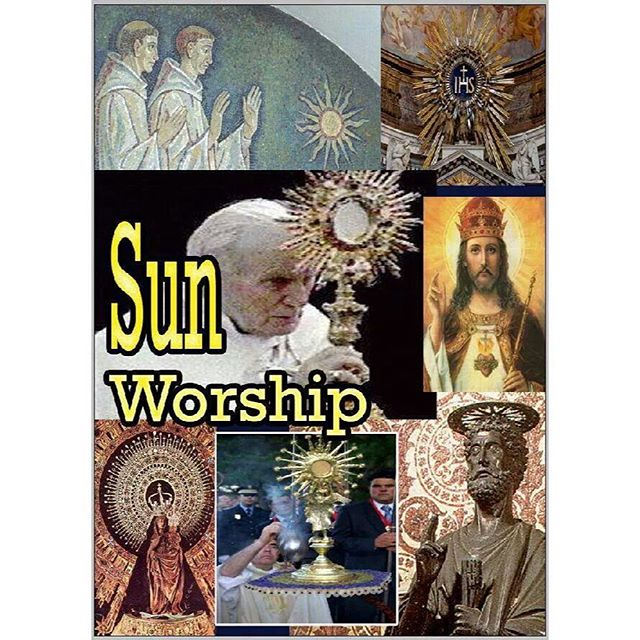
The word easter may not be pagan in it of itself, but the Roman Church has certainly given the word a pagan connotation & stigma by attaching endless pagan traditions.
The Real Morning Star
For ages the pagans have exalted their sun-god, Baal, and venerated their “Queen of Heaven” as the “Brilliant Morning Star” – which is exactly what the name Lucifer means (Isaiah 14:22). However, there is no brilliance of the Luciferian stock which can even hold a candle next to the preeminent Morning Star of the Most High! No devil which can spring forth in the same way Christ Jesus rose-up from the dead to give a most severe blow to the head of that serpent of old! And His saints will rise as He did on that great day!
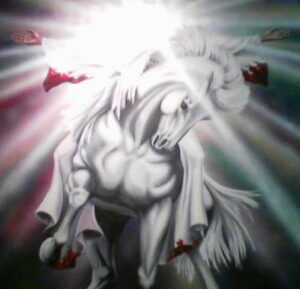
“I, Jesus, have sent My angel to give you this testimony for the churches. I am the Root and the Offspring of David, the bright Morning Star“ – Revelation 22:16
I am glad to know there are many Christians out there who do not want the corrupted pagan elements mixed with the celebration of the Resurrected Christ, who are zealous for keeping themselves & their faith sanctified. Yet zealous drives can be misguided with speculation & assumptions; so I exhort my fellows to do their diligence in searching out things more thoroughly before drawing conclusions.
As for me, I still have my reservations about using the word easter to identify the Resurrection of Christ, and to avoid any confusion & misunderstanding, I think it’s much more clear and concise to call it Resurrection Day. I am not offended by anyone calling it Easter, but I abhor the syncretistic practice of blending traditions of Satan with celebrations of the LORD.
“…what fellowship has righteousness with lawlessness? And what communion has light with darkness? And what accord has Christ with Belial?…” –2 Corinthians 6:14-15
Related Articles
Is the Name Easter of Pagan Origin?
Easter or Passover in Acts 12:14?
Ashtart – the Phoenician Great Goddess Eostre and the Easter Customs
From Passover Feast to the Lord’s Supper
The Son of God Joined with the Sun God |The Christmas Mixer
Mystery Babylon | The Luciferian Legacy
The New Age Movement and the New World Order
Other Sources
– Word & Spirit of God, Who Was and Is and Is to come
– John Clark Ridpath – historian, author ‘Ridpath’s Universal History’
– E H Broadbent – historian, missionary & author of The Pilgrim Church
– Albert Barnes – theologian, “Barnes’ Notes on the Entire Bible
– Adam Clark – theologian bible scholar, “Clark’s Commentary on the Bible“
– Richard Bennet – Christian historian & former Catholic Priest
– Alberto Rivera – high ranking Jesuit Priest converted to true Christianity
– Augustus Toplady – 18th century theologian & author of ‘The Road To Rome’
– John Foxe – historian & author of ‘Foxes Book of Martyrs’
– Bill Mencarow – theologian & historian
– Johanna Michaelsen – occult expert, author ‘The Beautiful Side of Evil’
– John Gill – bible scholar “Gill’s Exposition of the Bible“
– Kenneth Scott Latourette – historian, author of ‘A History of Christianity’
– John Todd Collins – high ranking Illuminati member converted to Christianity
– Michael de Semly – historian – Constance Cumbey- reseacher,author “The Hidden Dangers of the Rainbow”
– Frits Springmeier – researcher, author “Wise as Serpents”
– Will Durant – author of “A Story of Civilization”
Occult Sources
– Morals and Dogma – Albert Pike
–The Secret Doctrine – Helena Blavatsky
– A Manuel of the Lodge – Albert G Mackey
– Esoteric Philosophy Archive – Alice A Bailey
– The Secret Teachings of All Ages – Manley P Hall

